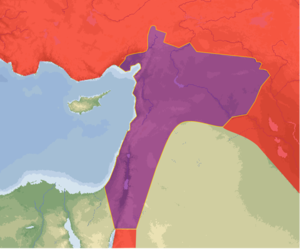| Shoubak Revolt of 1905 | |||||||
|---|---|---|---|---|---|---|---|
 View of Syria Vilayet | |||||||
| |||||||
| Belligerents | |||||||
| Inhabitants of Shoubak | |||||||
| Commanders and leaders | |||||||
| Ahmet Resber | Najab Al Wahib | ||||||
| Strength | |||||||
| 100 armed horsemen | N/A | ||||||
| Casualties and losses | |||||||
| 10 dead | 150 dead | ||||||
Location within Jordan | |||||||
The Shoubak revolts were a series of uprisings against Ottoman authority in the Transjordanian town of Shoubak that took place in 1900 and 1905. The second uprising started after the Ottoman forces started to put women of the town into forced labor, considered to be a deliberate act of punishment against the inhabitants of Shoubak who were frequently insubordinate. [1] Shoubak rose in revolt and managed to rally the neighboring Bedouins with them; the perpetuators were brutally punished by military force through an Ottoman expedition sent from Al-Karak, just north of Shoubak. [2]

